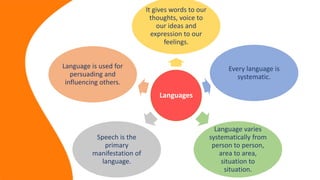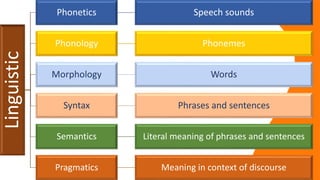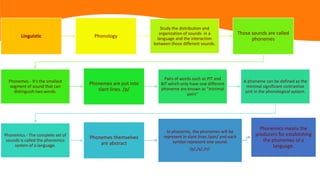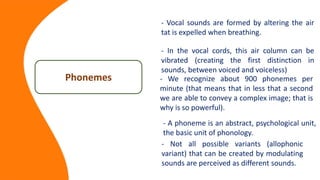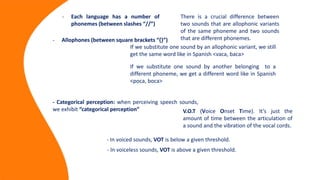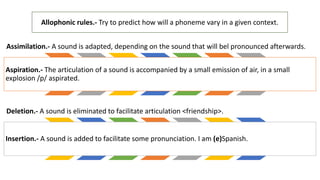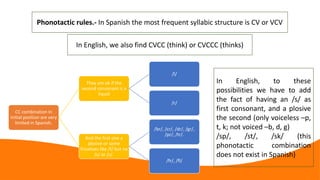Linguística
- 1. Languages It gives words to our thoughts, voice to our ideas and expression to our feelings. Every language is systematic. Language varies systematically from person to person, area to area, situation to situation. Speech is the primary manifestation of language. Language is used for persuading and influencing others.
- 2. Lingüística Psicolingüística Se interesa en comprender la adquisición del lenguaje (oral, escrito, etc), tomando en cuenta la parte psicológica del ser humano. Codificación: Producción del lenguaje. Descodificación: Comprensión del lenguaje. Sociolingüística Es la disciplina que estudia los distintos aspectos de la sociedad que influyen en el uso de la lengua, como las normas culturales y el contexto en el que se desenvuelven los hablantes. La sociolingüística puede determinar atreves del análisis de las actividades sociales que el uso de una jerga se considera inapropiada en ciertos contextos profesionales. Dialectología Explora y estudia las variaciones geográficas de la lengua, entre dialectos en áreas rurales y urbanas. Cada persona tiene su propio dialecto dependiendo de la región a la que pertenece, por Ejemplo En Ecuador el habla de los Manabitas difiere al habla de los Quiteños y de todos los demás hablantes. Procesos psicolingüísticos
- 3. Linguistic Phonetics Speech sounds Phonology Phonemes Morphology Words Syntax Phrases and sentences Semantics Literal meaning of phrases and sentences Pragmatics Meaning in context of discourse
- 4. Linguistic Phonology Study the distribution and organization of sounds in a language and the interaction between those different sounds. Those sounds are called phonemes Phonemes.- it’s the smallest segment of sound that can distinguish two words. Phonemes are put into slant lines. /p/ Pairs of words such as PIT and BIT which only have one different phoneme are known as “minimal pairs” A phoneme can be defined as the minimal significant contrastive unit in the phonological system. Phonemics.- The complete set of sounds is called the phonemics system of a language. Phonemes themselves are abstract In phonemic, the phonemes will be represent in slant lines /pan/ and each symbol represent one sound. /p/,/a/,/n/. Phonemics means the producers for establishing the phonemes of a language.
- 5. Phonology Studies how sounds interact as a system in a particular language. Pronunciation Is the way how we pronounce some words and expressions. Stress of a word or a sentence. In a word, the stress is the syllable (segment) which has more intonation. A correct stress is important to give the correct meaning that we want. Present Present Intonation The intonation describe how the voice falls and rises in speech. The intonation have tree main patterns: - Falling intonation. -Rising intonation. Fall-rise intonation. Phonologicalfactors Stress of a Word or a sentence Intonation In one word, we accentuate one syllable. We say one syllable very loudly and all the others syllables very quietly. PHO-to-graph Pho-TO-graph-er Pho-to-GRAPH-ic Falling intonation (is very common in wh-questions) Rising intonation (is very common in yes- no questions) Fall-rise intonation we use it at the end of statements when we want to say that we are not sure, or when we may have to add…
- 6. Besides the production of sounds, differences among phonological systems can also affect the identification of sounds Spanish speakers have problems distinguishing some consonants and vowels English sounds. The symbols are arbitrary and represent sounds typical of each language. English: There are phonological symbols that do not exist in Spanish but, they are very typical of English Spanish: There are phonological symbols that do not exist in English but are typical of Spanish Every languages have their own phonological symbols
- 8. Phonemes - Vocal sounds are formed by altering the air tat is expelled when breathing. - In the vocal cords, this air column can be vibrated (creating the first distinction in sounds, between voiced and voiceless) - We recognize about 900 phonemes per minute (that means that in less that a second we are able to convey a complex image; that is why is so powerful). - A phoneme is an abstract, psychological unit, the basic unit of phonology. - Not all possible variants (allophonic variant) that can be created by modulating sounds are perceived as different sounds.
- 9. - Each language has a number of phonemes (between slashes “//”) - Allophones (between square brackets “{}”) There is a crucial difference between two sounds that are allophonic variants of the same phoneme and two sounds that are different phonemes. If we substitute one sound by an allophonic variant, we still get the same word like in Spanish <vaca, baca> If we substitute one sound by another belonging to a different phoneme, we get a different word like in Spanish <poca, boca> - Categorical perception: when perceiving speech sounds, we exhibit “categorical perception” V.O.T (Voice Onset Time). It’s just the amount of time between the articulation of a sound and the vibration of the vocal cords. - In voiced sounds, VOT is below a given threshold. - In voiceless sounds, VOT is above a given threshold.
- 10. Assimilation.- A sound is adapted, depending on the sound that will bel pronounced afterwards. Aspiration.- The articulation of a sound is accompanied by a small emission of air, in a small explosion /p/ aspirated. Deletion.- A sound is eliminated to facilitate articulation <friendship>. Insertion.- A sound is added to facilitate some pronunciation. I am (e)Spanish. Allophonic rules.- Try to predict how will a phoneme vary in a given context.
- 11. Phonotactic rules.- In Spanish the most frequent syllabic structure is CV or VCV In English, we also find CVCC (think) or CVCCC (thinks) CC combination in initial position are very limited in Spanish. They are ok if the second consonant is a liquid /l/ /r/ And the first one a plosive or some fricatives like /f/ but no /s/ or /z/. /br/, /cr/, /dr/, /gr/, /pr/, /tr/. /fr/, /fl/ In English, to these possibilities we have to add the fact of having an /s/ as first consonant, and a plosive the second (only voiceless –p, t, k; not voiced –b, d, g) /sp/, /st/, /sk/ (this phonotactic combination does not exist in Spanish)
